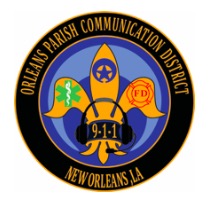

FOR IMMEDIATE RELEASE
Orleans Parish Communications District and Uber Launch
9-1-1 Information Sharing in New Orleans
New Technology Transmits Real-Time Location, Car Information to 911 Through Uber Emergency Button
NEW ORLEANS, LA (December27, 2019) – Uber has expanded its 9-1-1 information sharing program to include New Orleans. This means that when a rider or driver uses the in-app emergency button to call 911, key trip details that can be used to help respond to an emergency will now be available to 911 dispatchers with the Orleans Parish Communication District (New Orleans 9-1-1).
Since May, riders have been able to see their GPS location and car details (make, model, color, and license plate) in the app when they tap Uber’s emergency button to call 911 and tell dispatchers that information. Now, those details will be available to 911 dispatchers electronically in New Orleans.
“Location accuracy is the most critical piece of information for any 9-1-1 call. New Orleans is a premier destination city and last year we welcomed over 18 million visitors. Many of our 9-1-1 callers are unfamiliar with the area and this new technology will greatly improve our ability to get the right people, to the right place, at the right time”, says OPCD Executive Director Tyrell Morris.
Uber launched the emergency button feature in the app for riders and drivers earlier this year. In some cities, Uber partnered with RapidSOS to pilot 911 integration with local emergency authorities. The initial launch cities included Denver, Nashville, and a few other cities. It is now live in more than 30 US cities including Phoenix, Washington, DC, and Los Angeles. Starting today, the feature is now live in New Orleans too.
“At Uber, we believe technology can help make the roads safer than ever before,” said Andrew Hasbun, Safety Communications Manager at Uber. “Every second counts in an emergency, and we want to make sure our users get help quickly with accurate information if faced with an emergency situation,”
A recent Wall Street Journal article, Why Uber Can Find You but 911 Can’t, noted that roughly 80 percent of the 240 million calls to 911 each year are made using cellphones, according to a trade group that represents first responders. Data from the National Emergency Number Association (NENA) shows most 911 centers receive both the caller’s wireless phone number and their estimated location information.
Since wireless phones are mobile, the location of the closest cell towers (triangulation) may provide a general idea of the caller’s location, but that information is not always specific enough. That is why one of the first questions when you call 911 from cell phone is “what is your location?” as shared by the Federal Communications Commission (FCC).
Federal regulators estimate about 10,000 lives could be saved every year if first responders were able to get to a 911 caller just one minute faster.
The feature, which shares trip details automatically, is only available in the City of New Orleans. Uber and RapidSOS are working with cities to expand this technology to other jurisdictions. This feature does not replace the information that 911 currently receives through the wireless carriers during a 911 call — rather, it is an additional tool for dispatchers to use in an emergency.
This is feature is coming to New Orleans as the city gets ready to celebrate New Year’s Eve! New Year’s Eve is expected to be a busy night for Uber, as many riders look for a safe, reliable way to get home after their celebrations. Here are a few helpful tips for celebrating the big night safely:
- Message your Driver: Getting picked up in crowded areas can be tricky. To help you communicate with your driver, you can send messages or call your driver through using the Uber app. You can share a quick tip (“I’m wearing a red jacket”) or send your driver a pre-populated update like “be right there” with a single tap. Your messages are read aloud, and drivers can simply tap to respond, so your driver can keep their attention on the road.
- Check your ride: It’s likely other riders in your location will be looking for their Ubers the same time you are. To make sure you get in the right ride with the ride driver, verify the details in the app match who is picking you up. Confirm the driver looks like the picture and check the license plate and vehicle make/model.
- Share your trip: If your loved ones are counting down to your arrival, you can share your status from the app as soon as you’re connected with a driver. This enables them to watch your progress on a map including your ETA, and see details about your driver, and vehicle make/model.
Assets/visuals for use:
- HD video of rider 911 button
- GIF of rider 911 button
- BROLL of test calls in Denver
- BROLL of driver emergency button
- GIF of driver emergency button
- Sound bites with Sachin Kansal, Head of Safety Products, Uber
- Blog Post (initial launch)
About the Orleans Parish Communication District
Formed in 1982, the Orleans Parish Communication District is the PSAP for all emergency communications via 9-1-1 within Orleans Parish. The agency employs over 150 individuals and provides emergency medical dispatch, emergency fire dispatch, and emergency police dispatch for the millions of annual visitors and residents of the City of New Orleans. OPCD is a member of the Association of Public Safety Communication Officials (APCO) and the National Emergency Number Association (NENA).
For Media Inquires
Contact: Marcus Creel
Public Engagement Manager
601-319-2024
mcreel@911nola.org
For Uber: Andrew Hasbun
andrew.hasbun@uber.com
###
